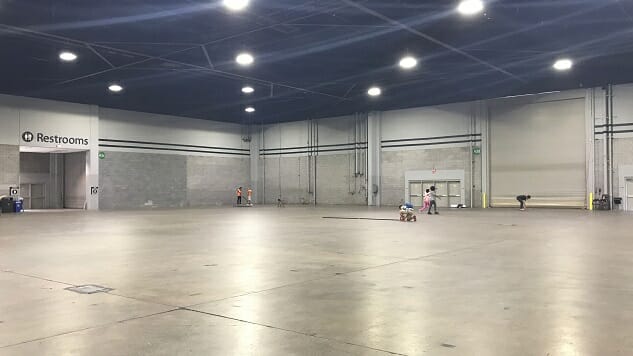DreamHack’s Sleeping Zone Isn’t as Nightmarish as You Think
Photos by Aiden Strawhun
Why leave the LAN when you can sleep at the LAN?
While concrete floors, sleeping bags, tape boundaries and hundreds of people might sound a little reminiscent of summer camp, it’s actually part of a long-held tradition at the 72-hour international LAN and e-sports tournament DreamHack: the sleeping hall.
DreamHack’s beginnings were humble compared to the flashy digital festival it has become today. It officially originated in the Swedish city of Borlänge in 1997, but its true roots are actually in various Malung basements and school cafeterias from 1994 to 1996. With time, it quickly became the largest LAN party in Sweden, attracting people from all walks of life—but its home city only had one hotel.
Enter the sleeping hall. Instead of making its jet-lagged and caffeine-riddled participants sleep snuggly with their set-ups or along center hallways for three straight days, they came up with a more viable and safer option, because there were no other options if they couldn’t get into the sole hotel in the city.
For the first time in the United States, DreamHack was able to continue this sleeping hall tradition at its recent LAN in Atlanta, and will do so again at its Denver LAN in October. For $20 a night, participants could bring their own comforts of home to camp out on the concrete floors of the Georgia World Congress Center, or pay $60 to get a mattress and blankets provided by partner and sponsor Leesa.
Getting nightmares yet? Relax. The sleeping hall is far from glamourous, but it was organized. It was an exclusive area to those who paid, with access to showers, bathrooms and security at all hours. Those with sleeping passes would check in at the desk in front, get a sticker or ticket for easy access and find a spot on the floor that they wanted for their stay. And for those who did go premium, all 25 of those mattresses and blankets are being donated to a shelter in the city.
“We want to make sure that they feel like it’s an exclusive experience,” Alex Gruenstein, of the DreamHack sales team, says. “I mean, you go to a hotel and you get treated a certain way, and we want to make sure that everyone that’s using the sleeping hall feels like there’s some ownership over that area because they’ve chosen to participate in it.”
Atlanta’s sleeping hall is a tad different from the average sleeping halls over in Sweden. In Sweden, the sleeping halls have room for 3,000 to 4,000 people. Atlanta’s could only hold 300. And instead of claiming your sleeping territory and leaving your things in one spot for the whole weekend, it’s a get in, get out type of situation. Participants check in, find their spot, get some shut-eye and when they get up for the day, they take their things with them.
But why test something out like this in Atlanta of all places? It was never allowed in the event’s location in Austin. Gary Briggs, head of DreamHack’s North American events, and Grunstein both say it may have been due to convention center rules, or city ordinances, but could not confirm the exact reasons why. Even when perusing the Austin Convention Center rules, I couldn’t find the exact rule that the sleeping hall would be violating, even in the fire code. There are no specific rules in the center’s document that prohibit people from sleeping in the convention center either. Atlanta’s own World Congress Center has similar fire code regulations and space specifications to Austin’s Convention Center, so this seems to be more of an approval issue over anything else.
The only thing separating you from everyone else is a thin line of tape and a wall of air. There is no privacy, but that didn’t seem to be an issue for those who took advantage of the hall.
